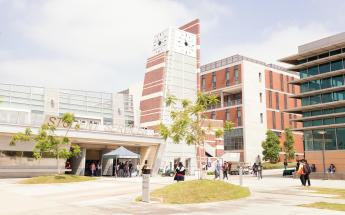Aquatic Specialist Certificate Course Descriptions

Program Learning Outcomes
The East Los Angeles College Kinesiology Aquatic Specialist Skills Certificate Program will provide an opportunity for students to become certified for employment in the aquatics field. Upon completing the required courses, students will be certified in First Aid/CPR, Lifesaving, and Water Safety Instruction (WSI). It is an aquatic certification for individuals who are seeking a career in aquatics. Specific occupations include lifeguarding, pool management, and teaching aquatic courses.
Students interested in pursuing a Bachelor's degree, should meet with an academic and/or transfer counselor to discuss transfer requirements.
Important Notice: In the event of a discrepancy between the information presented above and the online and/or print versions
Required Core Courses
This course will train and prepare students to recognize and care for various emergencies such as environmental injuries and sudden illness, cardiac and breathing emergencies, bleeding, and traumatic injuries for adults, children, and infants. Upon successful completion of the course, students receive an adult and pediatric first aid/CPR/AED certificate of completion.
This course is an introduction to the discipline of Kinesiology, physical education and physical activity; and examines human movement from the perspectives of experience, research, and professional practice. Topics include: introduction to kinesiology, spheres of physical activity, motor learning, psychology of sport and exercise, biomechanics, physiology of exercise and the history, sociology, philosophy and pedagogy of physical activity. Discussion also includes becoming a physical activity professional and learning about careers in health, fitness, therapeutic exercise, teaching, coaching and sport management.
This course covers the content of the American Red Cross Lifeguarding program. Students learn how to provide care with the knowledge and skills to prevent, recognize and respond to aquatic emergencies. Lifeguarding includes water rescue skills, first aid, high-quality cardiopulmonary resuscitation (CPR)for breathing and cardiac emergencies, oxygen administration, and use of an automated external defibrillator (AED). Upon successful completion of the course, students receive a Lifeguarding certificate of completion.
This American Red Cross water safety instructor certification course teaches individuals how to instruct students in all levels of swimming and water safety skills. An American Red Cross-Water Safety Instructor certificate is granted upon the successful course completion and qualifying physical exam.
This course introduces students to basic aquatic skills, such as floating, kicking, and gliding, and incorporates the development, practice, and theory of basic swimming strokes. The course emphasizes the development of basic water safety techniques to assure confidence and mobility in aquatic activities and to help create confidence in the water, as well as an evaluation of physical fitness.
This course covers intermediate techniques of swimming, terminology, and fluid mechanics in water. Swimming strokes include freestyle, backstroke, breaststroke, and butterfly. Racing starts, flip turns, dives, and touch turns are introduced on a beginning level. Interval training concepts are introduced to build endurance. Indoor and outdoor water safety is reviewed in this course.
This course covers advanced techniques of swimming, terminology, and fluid mechanics in water. Swimming strokes include front crawl, back crawl, breaststroke, and butterfly. Racing starts, flip turns, dives, and touch turns are introduced on an advanced level. Advanced principles of training include interval training concepts, increase yardage and advanced breathing techniques to build endurance. Indoor and outdoor water safety is reviewed in this course.
This course helps prepare swimmers for the physical requirements of Advanced Life Saving and Water Safety instructor. Advanced techniques of swimming, terminology, and fluid mechanics in water are covered in this course. Swimming strokes include front crawl, back crawl, breaststroke, sidestroke, and butterfly. Racing starts, flip turns, dives, and touch turns are introduced on an advanced level. Advanced principles of training include: Interval training concepts, increased yardage, and advance breathing techniques to build endurance. Indoor and outdoor water safety is reviewed in this course.
Announcements
N/A
Upcoming Events
N/A
